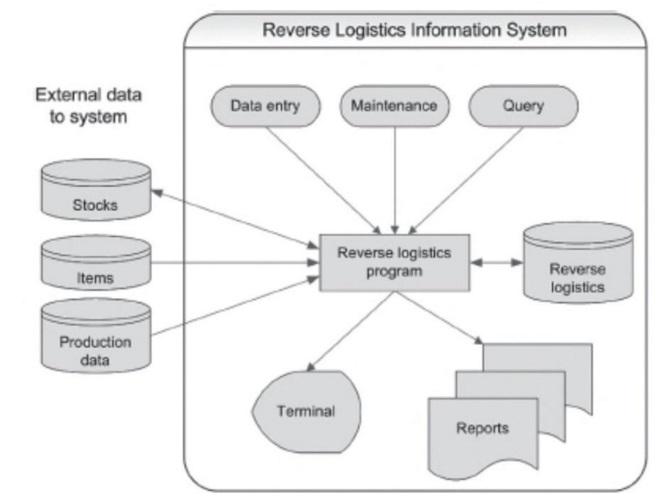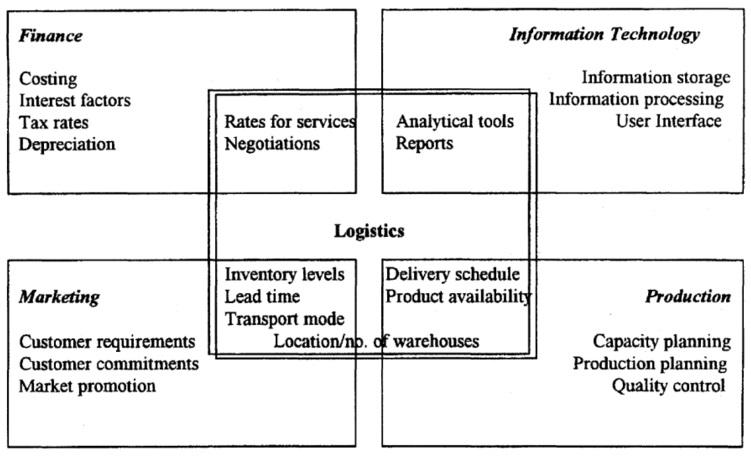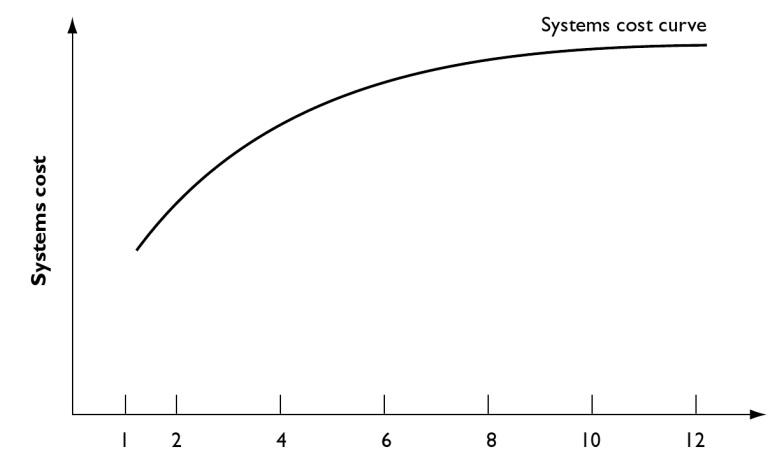Abstract
Information technologies are a comprising element in any sphere of human activity. Therefore, logistics is one of the target fields for proactive deployment of information systems. A large amount of literature has been published on that subject; however, there is a little evidence regarding methdolgy for implementation of information systems in logistics. That is the reason the following paper focuses on literature review and development of concept model for implementation of logistic information system. The paper explores reversed logistics information system, ER models, and other basic principles of IT and logistics. The study suggests its concept model as a complex of universal guidelines aimed at an integrated framework for information systems in logistics. It reveals that transparency of data and large presence of multiple applications for data collection are determining factors of effective implementation of logistic information system. Moreover, the study outlines expected outcomes and limitations to the research, namely the reason suggested findings can be regarded as objective.
Keywords: information system, logistic, RLIS, supply chain management, data transparency, logistic applications
Logistics Research Project
Nobody would argue with the fact that information technologies have penetrated almost all spheres of human activity. Logistics is a discipline that is far from exclusion as involvement of information technologies in supply chain environments is a central interest for many practitioners. In fact, contemporary literature pays much attention to a role of information systems in logistics; however, an issue of its effective implementation has been raged unabated. Each company prefers to implement information system in its logistics according to personal experience, best practice, or outsourcing the related services. Still, current knowledge is barely systematized in a complex and integrated set of guidelines and practices. Therefore, a need for creation of integrated concept model is apparent in theoretical and empirical senses. The following study gives an account on a literature review and development of concept model for implementation of information system in logistics.
Literature Review
Place New Order
A large volume of literature has been published on the subject of business information system in logistics. One of the main concepts related to a methodology of information system implementation is suggested by Abramowicz, Maciaszek, and Wecel (2011). Firstly, they suggest that any data should be conceptualized and addressed. That is the reason logistic information system should be placed in the environment with sufficiently diverse and convertible data. The main purpose of this method is to acknowledge an organization about a need for categorization of data, otherwise the information system will present figures which will not demonstrate any knowledge for decision-making. That is the reason Abramowicz, Maciaszek, and Wecel (2011) admit that information system can perform in various contexts present in companys performance. The latter are the main basis for data conceptualization.
Another contemporary requirement to logistic information system framework is integrity. The information system should be deployed as an integrated complex of applications, connections, and ways of processing data. Ait-Kadi, Chouinard, and Marcotte (2012) suggest that a model of reversed logistics information system is the easiest to integrate in that regard. It is evident as this model includes a specification of data at any stage of a supply chain. Therefore, all data are traceable throughout the entire life-cycle. Likewise, such a model has access to any type of information, as the picture presents below. Ait-Kadi, Chouinard, and Marcotte (2012) argue that a model of reversed logistic information system renders a better traceability owing to its structure. This confirms the reason implementation of an integrative model requires a specific environment for RLIS, availability of all data within an entire supply chain. A common practice suggests that the rest of supply chain members usually agree to integrate their data with their regular partners; therefore, Ait-Kadi, Chouinard, and Marcotte (2012) place the emphasis on a practical advantage of such a methodology.

Figure 1. Reverse logistics information system.
Gunasekaran and Sandhu (2010) promote an entirely different view claiming that information system in logistics should be implemented according to organizational structure and culture. Practically, this assumption is relevant in many ways. Firstly, organizational structure determines priorities of decision-making within a company so that a respective structure of information system should be also present. Provided that a company has a top-down organizational structure, all decision-based data are a priority for senior managers meanwhile bottom-up companies are better to adopt hierarchy-free information systems. Moreover, a provision of conditions for culturally diverse and friendly interface is also a requirement. Language barriers or any other cultural obstacles may become a strong problem for effectiveness of information system.
It is becoming increasingly difficult to ignore a trend such as data transparency, which is crucial for logistic information system. Bradford (2015) suggests that ERP SCM model is the best technology for practicing transparent data for the entire supply chain. It is certainly true, as this model traces products at all stages of supply chain in order for suppliers, manufacturers, warehousing facility, and a company itself to be able to keep track of delivered, lost, damaged, or unnecessary goods. It is obvious that data transparency renders a dramatic decrease of inventory, which is a distinct benefit for each party. Bradford (2015), however, admits that implementation of logistic information system on a basis of ERP SCM model presupposes an initial deployment of real-time business analytics. Otherwise, irrelevant decision-making knowledge will be delivered to the entire supply chain.
Consequently, collection of data is preexisting requirement for integrated and transparent implementation of logistic information system. Gregor and Hart (2010) claim that collection of different data is possible via incorporation of multiple applications. A proactive involvement of various applications can be justified with the fact that processing of data is always present in a particular context. Thus, each application can be used for various contexts and related business events. That is the reason a need for multiple applications as well as for an integrated structure of information system in logistics is apparent. Gregor and Hart (2010) associate that with a respective requirement of overall availability and accessibility of these implications. However, organizational structure may contribute specific hierarchical changes. Gegor and Hart (2010) suggest that none of data aspects should be neglected in that regard. Henceforth, implementation of logistic information system must be accompanied with a maximum of applications for data collection.
Eventually, the basic though essential principle of information system implementation should be indicated. Parthasarathy (2010) assumes that information system should be implemented in accordance with elaboration principle. The latter suggests that implementation should connect pre-operational and post-operational conditions. To the greatest extent, information system in logistics should be recognized as a mean of making a positive operational change. This statement is obviously relevant as Parthasarathy (2010) places the emphasis on the fact that a form of implementation does not matter once it is expected to deliver desired post-operational outcomes. Hence, it is arguable that implementation of logistic information system is suggested to be goal-oriented. One may state that information system should not address a single purpose of a company. That is the reason a large presence of flexibility and integration are extremely necessary for a contemporary logistic information system.
Concept Model
Taking the general statements of the literature review into account, it is necessary to develop a concept model for implementation of logistic information system. Primarily, it is informative to note that applications of collecting data and ERM SCM technology should render a distinct decision-making (Farahani, Rezapour, & Kardar, 2011). The illustration below depicts the transformation of data into a factual decision. Hence, implementation of information system in logistics should address a principle of elaboration. In many cases, a logistic organization needs to enhance and facilitate its decision-making process; thus, a preexisting context for information system implementation is apparent (Farahani, Rezapour, & Kardar, 2011). The implementation must depend on specific conditions of a company and simultaneously meet expected requirements. Therefore, the deployment of multiple applications for collection of data is recommended to follow a pattern of reversed logistics information system. Consequently, implementation should consider categorization principles for ability of the system to allocate various types of data.
- Our custom writing services includes:
- Plagiarism and AI free custom writing for the best grades;
- CV, resume and cover letters which would
make you successful - Thesis and dissertations writing by academic
authors


Figure 2. Role of information in logistic decision-making.
The second recommendation of the concept model is development of interactive reporting tool and simplicity of user interface. Reporting should follow a pattern determined with organizational structure of a company. For that reason, the literature review has paid a particular attention to relations between organizational layout and hierarchy of logistic information system. In the same vein, user interface should be diversity-friendly and easyly integrated with other aspects of a companys performance (Kasilingam, 2013). Information system is a comprising element of any logistic company as the figure below demonstrates (Kasilingam, 2013). Thus, implementation of logistic information system should be context-sensitive. Such sensitivity can be rendered throughout integrated approach of RLIS model as well as by incorporation of various sources of data collection. That will render a better reporting and overall flexibility for average users as well as for main decision-makers. Overall, organizational structure requires a certain hierarchy only meanwhile the rest of the objectives are similar to any company.

Figure 3. Position of IT in logistics.
Furthermore, a concern regarding costs is an important consideration for implementing logistic information system. It is hard to argue that information systems are often associated with a cost-effective business tool. It is certainly true;however, one should not confuse cost-effective outcomes of business information system with its factual funding. The same rule is applicable to logistic information system since its implementation is almost never recognized as cost-effective. Instead, reduction of inventory and according increase of its turnovers, suggestion of better routes, and auditing of fuel or carbon footprints are parameters that suggest cost-effective decisions (Rushton, Croucher, & Baker, 2014). That is the reason logistic information system does not necessarily have to be economized on but promoted as the central driving force of decision-making in regards to logistic operations and supply chain management (Rushton, Croucher, & Baker, 2014). The graph below demonstrates that increase in costs spent on implementation of logistic information system directly reflects a growth of data processed via multiple applications.

Figure 4. Growth of expenses on IT according to the increase of logistic network.
In addition, environmental orientation of logistic information system is apparent to a contemporary logistics. Firstly, factual implementation of logistic information system should be environmentally-friendly in regards to data warehousing and presence of other equipment (McKinnon, Browne, Whiteing, & Piecyk, 2012). Secondly, logistic information system is supposed to address environmental considerations on a large scale. As aforementioned, logistic information system should render a better decision-making for decrease and optimization of inventory, tracing to-be-delivered goods, and correction of routers (McKinnon, Browne, Whiteing, & Piecyk, 2012). These benefits imply reduction of air pollution and other environmental impacts. Therefore, an integrated information system is required to include calculation of carbon footprints for consideration of less harmful routes and accuracy in terms of inventory reduction. These activities are possible throughout a proactive use of ERM SCM transparent technology and structuring of information system according to reversed logistics.
After implementation of all the aspects described, training is a natural requirement for any recently adopted logistic information system. A common practice suggests that training should comprise learning of related to the system skills and verification of its user interface. Organizational structure and culture matter in this case. Training should be conducted according to these peculiarities in a company (USAID, 2009). Outcomes of the training, however, should be oriented towards a specific template. In other words, adoption of best practice is essential for training. Thus, focusing on UPS Global View technology as the most prominent logistic information system is a reasonable strategy regarding training of workers (UPS Supply Chain Solutions, 2005). Overall, training may follow any patterns applicable to information systems and logistics once the suggested concept model is expected to be deployable by any organization. However, a need for involvement of best practice is worth a separate discussion.
What are you waiting for?
Order with 15% discount NOW!

Orientation towards UPS Global View and other technologies believed to demonstrate the best practice within the field is a compulsory element of logistic information system implementation. Many companies underestimate importance of the best practice. However, it is hard to argue with the fact that contemporary knowledge in the field of logistics and information systems is mainly based on the best practice of the top companies. Theoretical framework has been not changed dramatically throughout the years meanwhile the most prominent companies strive for a constant enhancement of their logistic information systems. Therefore, use of best practice for training and implementation of logistic information system is an essential element. UPS is commonly recognized as the leading company within a global market, and its expertise is valuable asset for any organization in that sense (UPS Supply Chain Solutions, 2005). Generally, UPS standards are the central milestone for the suggested logistic information system.
Expected Outcomes and Limitations
In order to present expected outcomes and limitations of a developed concept model, a heavy reliance on a complete involvement of business information technologies in logistics should be indicated. It is increasingly apparent that information technologies are a comprising element of any business, and a field of logistics clearly demonstrates this evidence. Therefore, the suggested concept model is supposed to fulfil a purpose of a close combination of logistics and business information systems. Information technologies are likely to become an indispensable component of modern logistics so that the concept model attempts to address this issue.
One more argument in this vein is that this concept model represents a new generation of generic approaches to logistics. Proactive involvement of IT, environmentally-friendly models, and best practice of UPS is suggested to be the main foundation for effective generic logistic models. Thus, the concept model is expected to represent a result of best practice combined with profound use of IT and consideration of environmental impacts. These constraints are the key trends in logistics that cannot be ignored. At any rate, the concept model is supposed to serve universal purposes of any organization without respect to its position within a supply chain.
Eventually, it is informative to note that the main limitation of the research and developed concept model is absence of feasibility and costs estimates. The study, however, has mentioned that costs should not be economized due to the fact that information system will reduce costs of other logistic components. Expenses are a practical concern for many organizations. Likewise, a general feasibility of such a complex model is hard to estimate once each organization deploys its unique means of information flow, warehousing, transportation, etc. Furthermore, a common trend on outsourcing of logistic operations reduces a need for in-depth comprehension of logistic information systems.
Conclusion
It is appropriate to make a general comment on the fact that contemporary logistics needs a proactive involvement of business information system. This paper has given an account of methodology for implementation of information system in logistics. A wide range of theoretical as well as empirical literature has been published on a subject of information systems in logistics; however, little is known about considerations required for its effective implementation. The paper has developed a concept model based on initially conducted literature review. It is suggested as a complex of general guidelines regarding implementation. However, the concept model as well as the entire study implies limitations in relation to estimates of costs and feasibility of the designed framework. Thus, it is reasonable to suggest the further research to be focused on estimation of costs and experimental testing of the concept model in the empirical environment of logistics.
